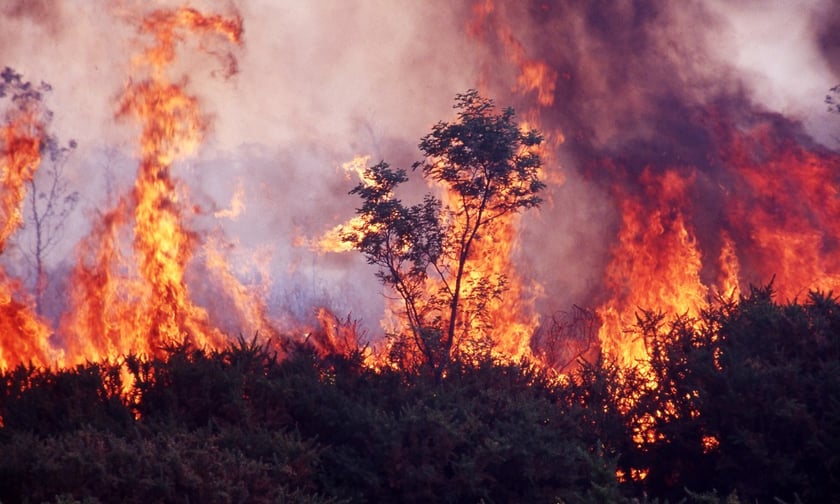

The surge in warm weather has caused wildfires across the UK, and more are expected.
According to The Evening Standard, “highs of 24C” are forecast today, with fire services warning of wildfires nationwide.
Jordan Barker, climate risk specialist at Beazley, noted that wildfire risks will likely rise, especially during summer: “The greatest increases to wildfire risk are expected to occur during the summer months, whilst a smaller increase in wildfire risk is also expected to occur during the spring season.”
Barker links these increasing risks to climate change: “As the effects of climate change are felt by the UK, we have seen an increasing proportion of warmer days that have presented heightened fire risk, compared to the historical average. Warmer, wetter winters allow for more vegetation to build up, while more frequent heatwaves will lead to drier vegetation, and in turn increased quantities of material available to be burned.”
While wildfires can strike anywhere, Kevin Dedieu, co-founder and chief scientific officer at Descartes, observes that some areas experience more frequent fires: “Wildfire can occur in a spread of areas across the UK. However, the majority of areas burned in the past 25 years are in the Northern Highlands regions in Scotland… That said, fires can occur down south too. Hampshire and the Isle of Wight record an average of 39 wildfires per year.”
According to Barker, the risk depends on the climate and landscape: “The largest British wildfires occur in ‘open landscapes’, particularly heath and boglands... Fires can spread quickly in these spaces, particularly in regions with peat bogs, which can ignite and continue smouldering long after the vegetation has burned away.”
Barker also warns that the southeast UK is highly vulnerable: “While only accounting for a smaller overall burned area, the largest frequency of fires occur in built-up areas and gardens, more common in the southeast of the UK. While these fires account for a low burned area, they pose a risk to life, properties, and infrastructure….”
Brokers must help clients prepare for wildfires, which includes simple preventive measures. Dedieu explained: “Most mitigation involves simple outdoor maintenance. Keeping vegetation away from buildings is one way to mitigate against wildfire risk. Another is to avoid gaps in roofs and walls that can trap blowing embers, for example, under broken roof tiles and in soffits.”
For high-risk properties, Dedieu suggests it’s advisable to keep a non-burnable, two-metre perimeter around any building or outbuilding. If refitting, consider avoiding flammable cladding and roofing materials, and decorating exteriors with non-flammable paint, he added.
Parametric insurance offers a promising solution for claims processing.
According to Allied Market Research, “the parametric insurance market was valued at $18 billion in 2023 and is expected to grow, reaching $34.4 billion by 2033.”
“With wildfire risks, property damage may be clear at the claims stage, but parametric insurance also covers costs related to ‘non-physical damage’ such as emergency response, supply chain disruption, and denial of access,” said Gethin Jones, co-founder and executive director at Skyline Partners. “To do that effectively, the product structure and defined triggers need the appropriate level of precision for the risks that are being covered. Satellite data can therefore be a great tool for settlement triggers.
“It also makes the claims payments certain. Based on the defined claims calculation method and defined data set, the client knows exactly the claims amounts they will receive.”
For brokers, ensuring clients are well-prepared for claims is vital.
David Schechter, claims focus group leader – environmental at Beazley, stresses the importance of a client’s early engagement with insurers. “To ensure a smooth assessment and claims process, early engagement with your respective insurer is vital,” he said. “Once a wildfire or environmental disaster occurs, the best thing an insured can do is to alert their carrier straight away - many carriers have environmental experts and structured response teams that can assist immediately.”
Schechter also highlights the importance of communication and pre-established protocols:
“Timely, clear communication is essential, as is having pre-agreed protocols in place with emergency response vendors,” he said. “Knowing who leads communications internally also avoids confusion at critical moments.”
Brokers play a crucial role in informing claims processing too. “The more ‘knowns’ we have early on — whether it's site conditions or policy details — the quicker and more effectively we can process claims and get businesses back on their feet,” Schechter concluded.
